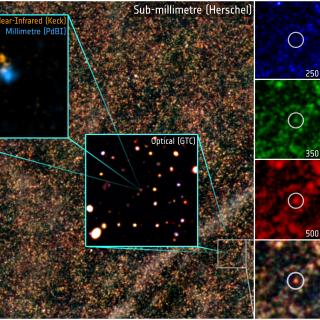Bibcode
Langeroodi, Danial; Hjorth, Jens; Chen, Wenlei; Kelly, Patrick L.; Williams, Hayley; Lin, Yu-Heng; Scarlata, Claudia; Zitrin, Adi; Broadhurst, Tom; Diego, Jose M.; Huang, Xiaosheng; Filippenko, Alexei V.; Foley, Ryan J.; Jha, Saurabh; Koekemoer, Anton M.; Oguri, Masamune; Perez-Fournon, Ismael; Pierel, Justin; Poidevin, Frederick; Strolger, Lou
Referencia bibliográfica
The Astrophysical Journal
Fecha de publicación:
11
2023
Revista
Número de citas
92
Número de citas referidas
70
Descripción
A tight positive correlation between the stellar mass and the gas-phase metallicity of galaxies has been observed at low redshifts. The redshift evolution of this correlation can strongly constrain theories of galaxy evolution. The advent of JWST allows probing the mass-metallicity relation at redshifts far beyond what was previously accessible. Here we report the discovery of two emission line galaxies at redshifts 8.15 and 8.16 in JWST NIRCam imaging and NIRSpec spectroscopy of targets gravitationally lensed by the cluster RX J2129.4+0005. We measure their metallicities and stellar masses along with nine additional galaxies at 7.2 < z spec < 9.5 to report the first quantitative statistical inference of the mass-metallicity relation at z ≈ 8. We measure ~0.9 dex evolution in the normalization of the mass-metallicity relation from z ≈ 8 to the local universe; at a fixed stellar mass, galaxies are 8 times less metal enriched at z ≈ 8 compared to the present day. Our inferred normalization is in agreement with the predictions of FIRE simulations. Our inferred slope of the mass-metallicity relation is similar to or slightly shallower than that predicted by FIRE or observed at lower redshifts. We compare the z ≈ 8 galaxies to extremely low-metallicity analog candidates in the local universe, finding that they are generally distinct from extreme emission line galaxies or "green peas," but are similar in strong emission line ratios and metallicities to "blueberry galaxies." Despite this similarity, at a fixed stellar mass, the z ≈ 8 galaxies have systematically lower metallicities compared to blueberry galaxies.
Proyectos relacionados

Anisotropía del Fondo Cósmico de Microondas
El objetivo general de este proyecto es determinar y estudiar las variaciones espaciales y espectrales en la temperatura del Fondo Cósmico de Microondas y en su Polarización en un amplio rango de escalas angulares que van desde pocos minutos de arco hasta varios grados. Las fluctuaciones primordiales en la densidad de materia, que dieron origen a
Rafael
Rebolo López

Formación y Evolución de Galaxias: Observaciones Infrarrojas y en otras Longitudes de Onda
Este grupo desarrolla varios proyectos extragalácticos en diferentes rangos del espectro electromagnético utilizando satélites y telescopios en tierra para estudiar la evolución cosmológica de las galaxias y el origen de la actividad nuclear en galaxias activas. En el aspecto instrumental, el grupo forma parte del consorcio internacional que ha
Ismael
Pérez Fournon